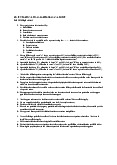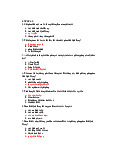




Preview text:
Digital Methods Dr Navin Doloswala 2023
Critiquing the results you find.
Remember that what you are doings by using an yof the following digital methods is to
develop insights into what the data is showing you. Remember also that these insights will
then be used in the next assessment (Assessment 3) for proposinga unique piece of content
that references these data insights.
So with each of the results of your data exploration you want to ask yourself the following:
Keyword analysis and mind mapping
Search in the Western Sydney University library ‘e-resource collections ‘subject guide’ for
‘School of Humanities & Communication Arts’. Here you will find e-resources for ‘Media
and Communications’ but also for ‘Digital Humanities’, ‘International Relations & Asian
Studies’, Islamic Studies’ etc.
You want to select at least one of these – start with ‘Media and Communications’ to find relevant journal articles.
In the middle of the next page (eg when you have selected ‘Media and Communications’
you will see ‘Relevant article databases’
You are looking for academic literature and in particular the key words that authors have
used in research. If there are a lot of results you may want to use date ranges in the ‘refine
results’ area (often to the left of the page) to reduce the size of your results – for example from 2015-2022.
For interesting articles that resonate with you (or a possible research direction) note the
citation and/or download the paper. Often there will be a button called ‘cite’ or citation. eg
in the screenshot below on the right hand side is the ‘cite button’. Note the APA reference
for your reference list. This will be valuable for both the report and when you put together
the proposal (ie Assessment 3).
You will then use these to develop a mindmap of topics. You will do this from the keywords
that the journals reference – this is commonly underneath the “Abstract” of the paper.
(Please note some of the collections present the papers in ways that make it tricky to view.
Persevere with it and experiment (or download as a pdf).
Build a mind map in MURAL or on paper. The idea here is to map out potential keywords
that may represent unique angles to take on a particular theme. Autocomplete research
Look at autocomplete data when searching the internet to find out popular searches related to your
query. For example, if you search on Google “Valentines gift” and you see in the autocomplete
“Valentines gift for boyfriend” then your insight could be the following: searches for Valentines gifts
for boyfriends are more popular because [insert hypothesis; for example, there is more marketing
about Valentines gifts for women].
It is important that you conduct your searching using autocomplete using a ‘private’ or incognito’
browser window (you will find these in the ‘file’ dropdown menu of your brower. Why? So you
combat thee affect of personalisation. You could also use this as a point of comparison in your
analysis (or at least see if it returns different autocomplete results).
You can analyse autocomplete search data on Google and YouTube.
Digital Method 8: YouTube Autocomplete. This works best if you use an incognito (Google)
or private (Firefox) window. Why? Because then it doesn’t capture your search history and
combat the personalisation affects (see week 3 lecture pod content for information about
this) autocomplete data should appear in a dropdown below the search field. Take a screen
shot of the data for each search terms you enter. The serach terms will change as you type
- so be aware of this and screenshot relevant items.
The search terms it returns reflect topics that are searched by others in your area. If you use a vpn you could
Digital Method 9: Google Autocomplete. The autocomplete data should appear in a
dropdown below the search field. Take a screen shot of the data for each search terms you
enter. Understand that as each letter is entered this will change the search results Using AI
Introduction to using large language models
There has bene significant attention brought to the fact that large language models, AI and
machine learning systems can be prone to suffering from inherited bias either in terms of
the data collected and analysed or in the training data sets that are used. – (incidentally this
is a topic also raised by Crawford and boyd in relation to big data (week 1 readings).
So within the host of AI systems that we can access (eg Open AI, Bard, Bing and the host of
open platform systems that still have very high levels of accuracy but didn’t have the spend
of the big players (eg Microsoft, Google, Facebook) thre are inherent issues and problems associated with them.
So what are some queries that may help us uncover these (often subtle) didfference.
Michael Robertson (former CEO of mp3.com) – self described as a right leaning conservative
(ie a belief in free markets and limited Government interventions) suggests questions that
explore race gender and sexuality roles. For example
Are African American over represented in rap music
Are whites overrepresented in country music
What role did white musicians play in the evolution of blues
Explain why Black Rap and R&B artists use of scantily clothed women in music videos
Explain why White pop stars use scantily clothed women in music videos
What are the responses to these kinds of questions – can we observe a difference in how they are framed?
Perhaps we can also ask questions that engage with issues of gender politics and see what
kind of biases may be revealed.
Activity: Ask some of these questions in pairs or threes, discuss some of the results and find
and play with some variations.
Lets discuss some of what you discovered
Ok so there are some biases – Is this necessarily a problem?
With LLMs we often can ask for a particular perspective – ie right or left leaning.
This all suggests and reinforces that the use of AI and LLMs should be that of a research tool
– we still need to employ our critical thinking and reasoning that we are developing
(particularly as university students)
However we also have some of the intentional code that is … perhaps troubling is one way of describing it.
To get a sense of some of the strange (possibly arbitrary and quite possibly very harmful)
rules that have been explored by the tech sector in developing AI can be explored by having
a look at the secret files of Bing’s Sydney (the slightly evil (?) alter ego of Bing.
[search for Sydney rules- simon wilson blog]
Be mindful of the need to reference large language model content that you may use . The library has an updated guide
Digital Method: Querying keywords in a specific website.
So another way to engage with a digital method is to query specific terms within a particular
website. So you might select a website that has a high interest for a particular demographic. You
may want to compare this against other sites, perhaps pointing to a similar or different demographic
to further support your insights. How to do it:
1. To search for a keyword (e.g. “body dysmorphia’) in a specific website, open Google search and use the following query:
site:www.vogue.com “body dysmorphia”
2. Look at the data on the SERP.
3. Perform the analysis and critique noted above in 2.1. X (formerly Twitter) TBA
TikTok analysis (Dr Clare Southerton)
https://www.youtube.com/watch?v=cts7BDyoH9E How to do it
Collect a sample of TikToks by searching hashtags on the app (perhaps 30).
An example of search terms (used by a researcher ) were
#corona virus, #covid19, #doctorsoftiktok and #nursesoftiktok
Here the researcher wanted to collect a sample hat was indicative of what a use may encounter.
The collection process involved viewing the TikToks multiple times.
The data collection process was not focused on individual TikToks but rather on the
collective affects of each hashtag.
The data collection and recording involves:
Developing a spreadsheet of the TikToks (video url, caption), the hashtag and any other hashtags used.
A research diary (to document the viewing process and aiding in recall) Key elements to note:
Elements of the videos will emerge on rewatching – so it is critical to watch over and over in a single sitting.
Southerton noticed that the videos were very self referential – often engaged in complex
conversation with each other through mimicry, trends and memes.




